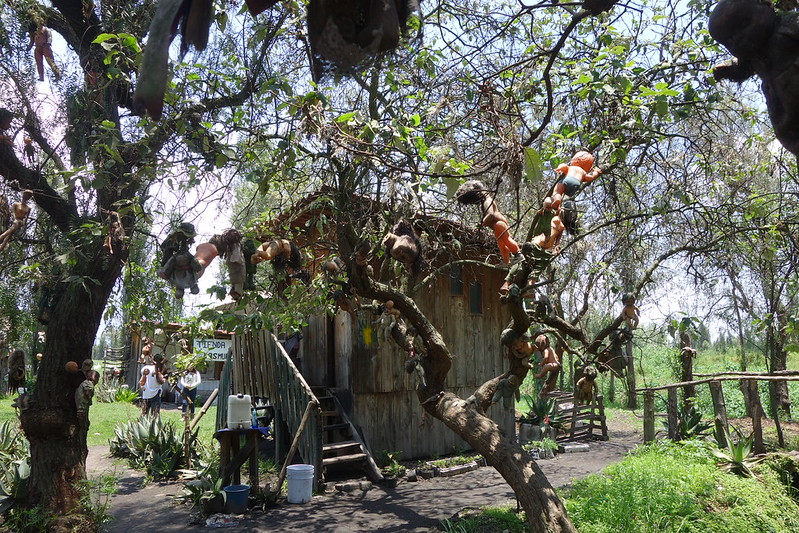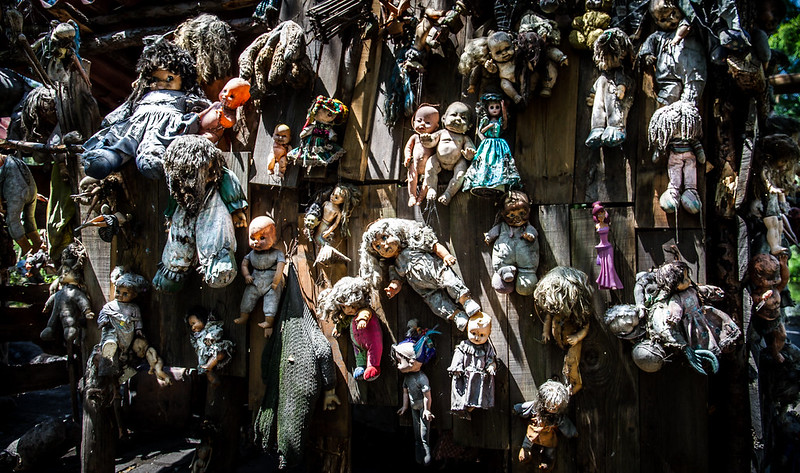The Island of Creepy Dolls
Mexico City, the capital of Mexico, has 16 official subdivisions called demarcaciones territoriales, or in English, boroughs. One of them, toward the south of the city, is Xochimilco, which is best known for its man-made canals. Centuries ago, much of what is now Xochimilco was a lake, but a lot of the shallower parts were filled in to allow for development. Boats navigated the remaining, deeper waterways, allowing people to go from island to island. Today, tourists and locals alike are often found on colorful ships passing through the canals and visiting the islands.
Nearly half a million people live in Xochimilco, but none of them live on the Isla de las Muñecas. That’s reserved for the creepy dolls.
That picture, via FlyingCrimsonPig on Flickr, shows some of the dolls hanging on the trees. Can’t quite make them out? Here’s another photo, via 53Kevin on Flickr, that gives a lot clearer — and creepier — view.
If covering an island with old dolls isn’t your idea of a good time, you may be confused as to why something like this could exist. Most likely, it’s because about 80 years ago, the then-owner of the island went mad. Don Julian Santana Barrera was born and raised in Xochimilco and raised a family there of his own. But at some point, probably in the mid-1940s, he abandoned his family and secluded himself on a small island in a one-room hut. As Discovery explains, any attempts at a life of peaceful seclusion were quickly shattered: “Not long after relocating, he made a chilling discovery on the shores of his island: the body of a young girl, drowned in the lake. A doll came floating down the canals shortly afterward, changing the course of Santana’s life and the shape of the island for years to come.”
Others would later say that Santana dreamed the whole thing, but it didn’t matter — he believed the girl and the doll really appeared, and he took the combo as a sign. He believed that the girl was going to haunt his island, and the doll was a way of warding off her spirit. Legend has it that he hung the doll from a tree — it was his way of showing reverence. In some versions of the story, a second doll washed ashore shortly thereafter, but either way, the doll habit began and quickly became unchecked. As Atlas Obscura reports, “Don Julian Santana began collecting lost dolls from the canals and the trash near his island home. He is also said to have traded produce he grew to locals for more dolls. Santana did not clean up the dolls or attempt to fix them but rather put them up with missing eyes and limbs, covered in dirt, and generally in whatever ramshackle state he found them in. Even when dolls arrived in good shape, the wind and weather turned them into cracked and distorted versions of themselves.”
Today, there are hundreds of dolls on the island. After Santana died in 2001 — apparently, he (also?) drowned just off the island — It’s become a tourist attraction of sorts — a dark one, for sure. Most of the rowers of the canal boats will gladly take visitors there, but not all — some are too superstitious to do so. And thanks to pop culture, you can (kind of) see the island without having to physically go there: in September 2025, Lady Gaga released a video for her song, “The Dead Dance,” which was filmed on the Isla de las Muñecas, (In real life, the dolls don’t move on their own, though… we hope.)
Bonus fact: Somewhere in Poland, as of 2018, there’s an island with exactly one resident: a cow. (Okay, I’m sure there are bugs and birds, too, but that’s not as much fun.) That year, as the Independent reported, a cow escaped from a slaughterhouse near Lake Nyskie (here’s a map) and made a mad dash for freedom. Ultimately, the cow went into the lake and swam to one of the small islands dotting the surface. The cow’s owner tried to get it back but, after a week’s effort, admitted defeat. After a public outcry on Facebook asking him to leave the cow be, he decided to let the cow live out its days on the island.
From the Archives: The Somewhat-Willing Inhabitants of Sorok Island: They can leave, but they don’t, and that’s a good thing.


